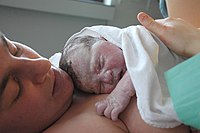
Photo from wikipedia
BACKGROUND The objectives of this study were to assess the number of organisms present on different surfaces within a clinical environment before and after cleaning took place, and to identify… Click to show full abstract
BACKGROUND The objectives of this study were to assess the number of organisms present on different surfaces within a clinical environment before and after cleaning took place, and to identify the impact of cleaning. The study involved extensive 2-week microbiological environmental monitoring of an entire ward before and after cleaning; the ward was located within a pediatric hematology-oncology ward comprised of a day unit and outpatient ward. METHODS Tryptone soya agar contact plates were used to take a total of 1,160 surface samples before and after cleaning from 55 predetermined sites. Samples were taken from representative surfaces throughout the ward representing a variety of materials, surface heights, functions, and distances from patients, as well as both high-touch and infrequently touched surfaces. RESULTS After surface cleaning was undertaken within the ward, there was a significant difference between the amount of colony-forming units (CFUs) recovered before and after cleaning (P < .0001). Cleaning produced an average CFU reduction of 68% throughout the ward environment. The corridor was the most contaminated area within the ward. There were differences in the CFUs among the various areas within the ward, which were cleaned with varying efficiency. The surface material, who interacted with the surface, levels of initial contamination, perceived risk, and perceived cleanability were all found to have a varying impact on the cleaning effectiveness. CONCLUSIONS To the authors' current knowledge, this is the only study to assess cleaning within a pediatric ward by taking samples directly before and after cleaning. The standard of cleaning undertaken within the ward is open for discussion, and these data highlight the need for an improved cleaning intervention and can provide insight into the multitude of factors that must be considered when designing an effective training protocol.
Journal Title: American journal of infection control
Year Published: 2019
Link to full text (if available)
Share on Social Media: Sign Up to like & get
recommendations!